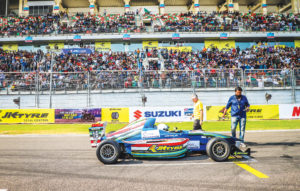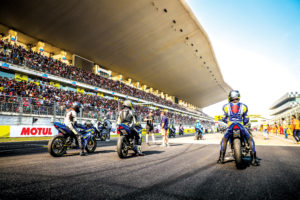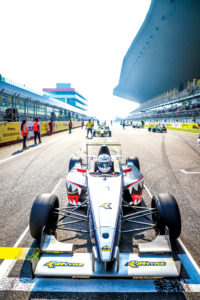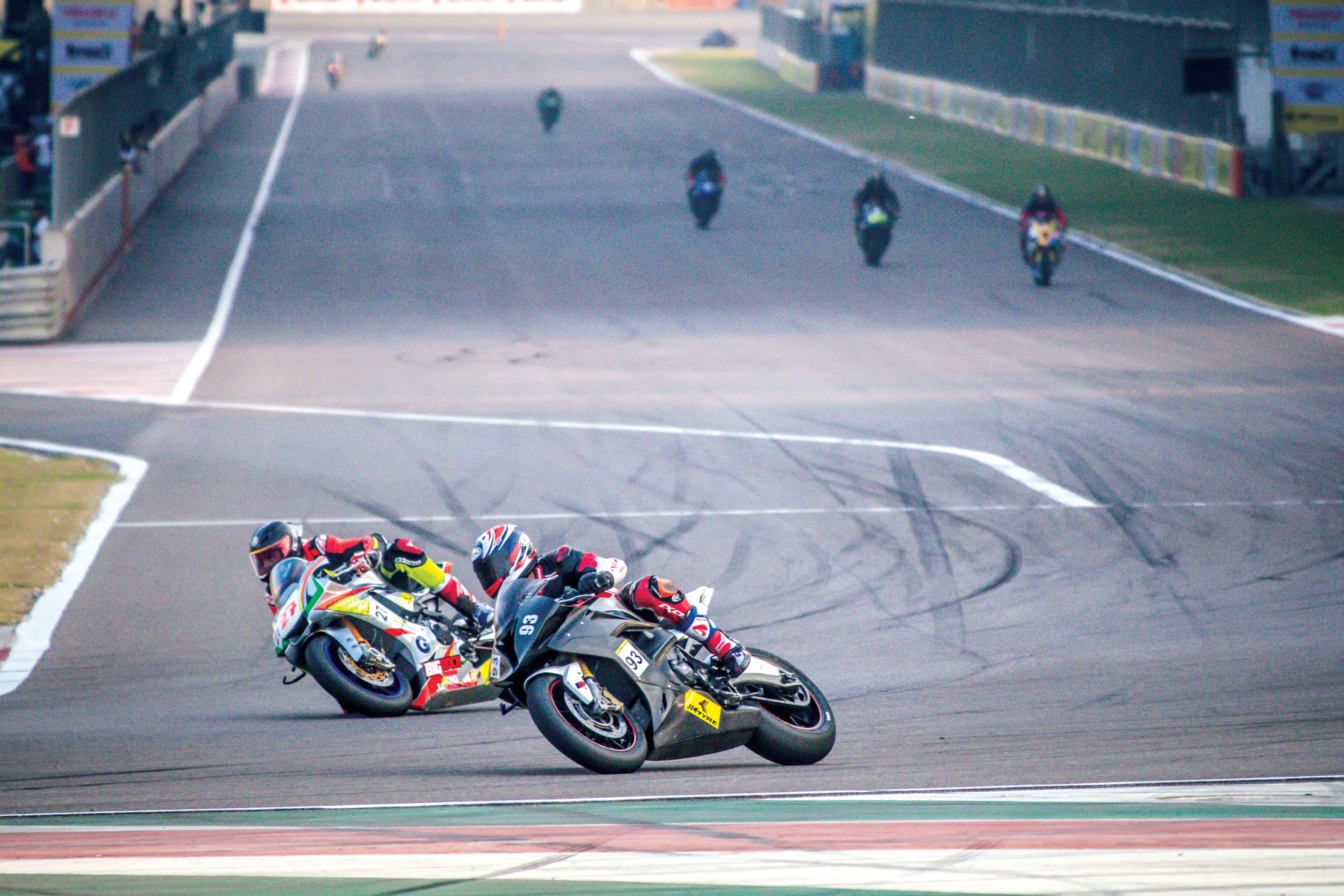India’s only F1 track in Greater Noida has not hosted the Grand Prix for five years but is kept buzzing with all kinds of events. Will this formula keep it afloat?
On the outskirts of Delhi, is where rows of apartment complexes, some occupied and many under construction, lead the way to the Buddh International Circuit (BIC). Celebrated as India’s first and only F1 track, it brought into the country the sport made famous to most millennials by Michael Schumacher.
But this track, with promises to keep and miles of concrete, has been unable to create a mark since opening in 2011, when it hosted its first F1 race. After 2013, the championship has not made a comeback. The culprit? High taxation – as India does not recognise motorsport as a sport but entertainment — and bureaucratic hurdles.
How then has the Jaypee Group been able to sustain a place built on 550 acres, after spending approximately Rs 2,000 crore, not to forget its maintenance cost ever since?

As per Jaypee Sports International Limited’s (JPSI) audited accounts, the company incurred a further cost of Rs 197.7 crore in licensing fee. This rose to Rs 249.6 crore ($39.1 million) by the third edition and additional operating expenses of Rs 121 crore ($19 million) were incurred for the inaugural edition of the race, taking the combined figure well past Rs 300 crore ($47 million).
Some reports quote recovery of just Rs 140 crore from the 2011 Indian Grand Prix, which further dropped to Rs 76 crore and showed some improvement in 2013 with earnings of Rs 113 crore.
In 2014, Jaypee Sport was amalgamated into Jaiprakash Associates. The expenditure and earnings of the track thereafter could not be accessed.
How it makes the moolah
Currently the championships taking place in the grounds are national racing events, like the one on 18th November, which saw JK Tyre host an event with Nagaland CM Neiphiu Rio as the chief guest. With features like Superbike racing, Euro JK 18 championship, and Formula 4 among others, it drew a large audience. The crowd, bursting at the seams, were not the average joe fascinated by racing, but were perhaps drawn in because of the free entry.
This is maybe where the country has failed in terms of making racing a sport of national interest. While an exorbitant amount has been spent and money keeps getting pumped in, the fact is not lost that it will never be a sport as loved as cricket. Rather it wouldn’t even compete with cricket for the government does not recognise motorsport as a sport.

An official with the Buddh International Circuit, says that the track hosts over 200 events every year. And this is how they are able to “break even.”
The circuit cashes in on national racing events, hosts the Asian racing championships, marathons and cyclothons. Keeping the space alive are concerts, like that held of David Guetta and the Sunburn festival. It also holds corporate events, shoots for advertisements — starting this year with Maruti’s Nexa, Tata Trucks, and Tag Heuer watch —and even individual memberships.
The range of events is from large scale ones like corporate events of BMW or Mercedes, and multinational corporations like Airbus, HDFC, ICICI, pharmaceutical companies like Dr Reddy, who get their clients or top management. Sometimes they host “annual days of corporates, which bring in 1,000-3,000 employees”. It’s for the rich and influential, who can pamper their clients or even its own, with the circuit providing helipads for the ones who would find driving all the way to Greater Noida, a tedious task.
Another interesting avenue which brings in revenue are services like Hot Lap and Arrive and Drive. The former is like a taxi service but for luxury cars and only on the track. A car and driver is provided to give you the experience of the track at a cost of Rs 3,000 for one lap.

Another is Arrive and Drive. People who cannot enjoy a drive in their luxury cars or bikes on the bumpy potholes and congested roads of Delhi-NCR can be seen zipping by on the track. A maximum of 10 persons can share the cost of Rs 1.25 lakh for an hour at the track; an individual would have to pay Rs 20,000 for an hour.
For an individual who does not have a car but wants to drive one can get it from the circuit. They can choose from one of their Mercedes cars or any of their customised race ready cars for Rs 15,000 for half an hour.
For those bringing their own cars, an option is the BIC membership card. One can pre-purchase six hours of riding hours for Rs 5 lakh plus 15% GST. So, the cost comes down to Rs 83,000 per hour plus taxes and you can avail these hours throughout the year. These members can also leave their cars and bikes at the parking lot.
You can see how they are trying hard to make the track commercially viable with an array of offers. They also have academies where people can learn how to drive. It opens its track to newcomers, and even advance level drivers for further training. The two-day course costs Rs 35,000, and one would have to get their own cars and bikes.
For those at level two and three, the costs go up because they bring in overseas instructors. This year, a partnership with Ducati saw riders from their programme compete at the World Superbike championship.
WHY NO F1
Still, the group is running into loss (Rs 4,361.57 crore; for details please see box), and obviously requires the cash, but the F1 could not make a comeback after a celebrated first year was followed by two years of low interest.
While the BIC official says they are “keen, ready and equipped to conduct any racing activity series”, the future of Indian Grand Prix lies with certain government policies and the F1 team’s ability to “deal with it and come to terms with it”.
Some of the blame lies with the “taxation, some of it with funding, and some with sponsorship.” And the only way it could happen again is if the “multiple partners”, work together says the official who does not want to be named. As organisers, he says, they do everything required to hold the event at the premises which is on the scale of FIFA. “The only difference with FIFA or Olympics is that it takes place in multiple venues. This is very compact and in four days it is over.”
“Fédération Internationale de l’Automobile (FIA), which conducts these races have been very keen. But they have to work very closely with the government, which they do with any other government where F1 is involved.” he points to the understanding of “these people to work with the policies of the government of India” adding that they need someone to make it easier.
The events generate interest and are good for the economy, with auto industries profiting from the marketing push, he says. Also, 47 people have full-time employment, while the food and beverage stalls also generate livelihoods, besides providing employment.
A bit of controversy
The Indian F1 circuit was brought into the international limelight after Mercedes’ star rider Lewis Hamilton made a comment about it. In an interview, he had stated how the race in India had left him feeling conflicted — the poverty of India being juxtaposed with the luxury of the track.
Needless to say, the comment didn’t go down well with many people, as any comment which portrays India as being poor is marked as disingenuous. It’s another thing that in 2012, the Indian government stated 22% of its population as below its official poverty limit. The World Bank’s “India Poverty Profile”, projects one in five Indians as poor. Its purchasing power parity (PPP) 2011, estimated that $1.9 a person a day was the purchasing power.
This conclusion came through the National Sample Survey Office (NSSO)’s new methodology of poverty estimation.
Getting back to the comments and its aftermath itself, Hamilton did not back down and instead took to Twitter to explain himself.
He first said that India was “one of the most beautiful places in the world. The culture there is incredible.” But went on to add that while it has a growing economy, it also has “a lot of poverty”.
He went on to state why exactly he made the comment in the interview to the BBC, “Grand Prix there felt strange — to drive past homeless people and then arrive in a huge arena where money was not an issue. They spent hundreds of millions on that track that is now never used. That money could have been spent on schools or homes for those in need. When we did have the race, nobody came because it was too expensive, most likely, or no interest. However, I have met some amazing India fans (sic).”
In the first year itself over 90,000 spectators came. The numbers fell in the second year but were back up again in the third.
Furthermore, as the track is privately owned by the Jaypee Group, where the government’s role could be questioned is the giving away of the land on minimal rates when the Census of 2011, shows that India has more than 1.7 million homeless residents, of which 938,384 are located in urban areas. According to the non-profit Housing and Land Rights Network, Delhi has some 1.5-2 lakh homeless persons.
But this debate is like a post-mortem, for the land is given and the track made. If anything, the way forward is to make BIC viable and see that all the players who could make the Grand Prix take place work together for that goal.
Burden of debt
In financial year 2016-17, the Jaypee Group reported a loss of Rs 4,361.57 crore. The group, according to its annual report, cited loans taken on the Jaypee Sports city near the F1 stadium. Canara Bank extended a loan of Rs 500 crore by way of “pari-passu charge over 25.007 acres of commercial land situated at Jaypee Sports City near F1 stadium”.
A further Rs 200 crore was sanctioned by Yes Bank by way of exclusive charge over 11.3095 acres of commercial land situated at Jaypee Sports city near F1 stadium.
Furthermore, Standard Chartered Bank gave Rs 35 crore, United Bank of India Rs 150 crore, Allahabad Bank Rs 100 crore, Karur Vysya Bank Rs 50 crore and South Indian Bank Rs 100 crore, which aggregates to Rs 750 crore. The outstanding amount was filed as approximately Rs 560 crore by exclusive first charge on pari-passu basis over 65.0263 acres of commercial land at the sports city.
A further Yes Bank loan of Rs 520 crores with outstanding amount at Rs 340 crores is shown by way of exclusive charge over 18.02 acres.





